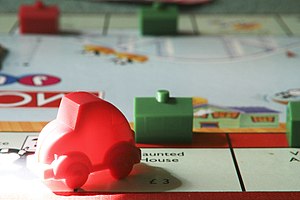Am I the only one who just noticed that it’s Wednesday? The holiday week with the free day is completely screwing me up.
Just to make this a relevant post:
Spend less!
Save more!
Invest!
Wee!
The no-pants guide to spending, saving, and thriving in the real world.
A few weeks ago, on my way to work, while merging onto the highway, a soccer mommy in an SUV decided that she was going to accelerate to fill the opening I was going to use. Not before I got there, which would have left her in the right, if still a jerk, but as I was moving into the lane.
The entire reasoning was that she could be rude and dangerous under the assumption that I would be more civilized and back down, allowing her to indulge her little fantasy about how the world works. Luckily I saw her speed up, and had time to move out of the way. Physics very nearly taught her an expensive lesson.
This is similar to the people who think they’ll be safe because “nothing has happened before” or think “He won’t hurt me because I;m a good person” when confronted with a mugger.
This is magical thinking. Basing assumptions of other people’s actions on nothing more than your personal hopes and biases. The truth is, your halo does not provide a shield. Your luck at dodging criminals while strolling through bad neighborhoods does not circumvent statistical likelihood and your jerkface attempt to run me into a guard rail had better be backed by the stones to deal with a wreck.
Magical thinking, wishful thinking, and baseless hope are not rational methods of running your life. Criminals hunt for victims who wrap themselves in a smug, yet naïve, superiority. Murphy’s Law is waiting for someone arrogant enough to think that the laws of physics don’t apply when you’re commuting. The only rational means of predicting the behavior of others is to look at the signals they are actually producing.
Someone tentatively trying to squeeze into an opening in traffic is far more likely to submit to your passive aggression than the guy who merges with a turn signal and the gas pedal.
Someone in the park after hours in a hoody is more likely to hurt you than the guy in running shorts.
The guy lurking in the shadows of the parking ramp, refusing to make eye contact is a more likely mugger than the suit trying to find his Lexus.
A million years of evolution have given us an incredible ability to detect danger. A few hundred years of relative peace at the end of a few thousand years of relative civilization have not erased that ability, it has just convinced us to ignore our instincts under the mistaken assumption that all predators live in the jungle.
Fear has survival value. Don’t allow your rational brain to override your lizard brain completely. Let your fear keep you safe.
In the US, haggling is something that makes a lot of people twitch and wet their pants. It’s too hard/scary/intimidating, so most of us just take whatever price is offered, with a smile.

The truth is, you can negotiate in almost any situation. Sure, big-box retailers with low-price goods–like Walmart or a grocery store–aren’t going to go for it, but a lot of other businesses will. Did you know you can haggle at Best Buy? It’s true, but only on the bigger ticket items.
You can also easily negotiate at place like these:
“Great”, you say. “Anyone can do it?”, you say. “But how, jerk?”
No need to call names, I’m getting to that part.
I am about to share the First Secret Lesson of Negotiating. This secret has been passed down from father to son among the celibate Shaolin monks for generations. Breaking the code of secrecy may be putting my life in danger, but I’m willing to do that for you, no matter the risk.
I rock like that.
Are you ready to be initiated into the secrets of the Ancient Masters? When our first abbot, Buddhabhadra, first wandered into the Northern Wei Dynasty branch of Best Buy in 477 A.D., he discovered the phrase most likely to break price barriers.
Are you ready, Grasshopper? This is the “Wax on, wax off” of effective negotiation.
When you are given a price, no matter what it is, say “Is that the best you can do?”
“This T.V. costs $7495.” “Is that the best you can do?”
“That comes to $56.95.” “Is that the best you can do?”
“$149,499 for the Ferrari.” “Is that the best you can do?”
“$12,000 for the kidney.” “Is that the best you can do?”
“Only $8.50 for this set of 10 tupperware lids that have been warped in the dishwasher.” “Is that the best you can do?”
“$50 an hour, honey.” “Is that the best you can do?”
“The salary for this position is $50,000 per year.” “Is that the best you can do?”
It is magical, it’s easy to remember, and it’s low stress. This is a non-combative question. The worst possible scenario involves the other side saying, “Yes, that is the best I can do.” No sweat.
After saying “Is that the best you can do?”, shut up. The other party gets to be the next person to say something.
Go out and practice this over the weekend. Master the First Secret Lesson of Negotiating. I’ll be fighting off Shaolin ninjas for sharing the ancient secrets.

Serial killers in the United States often gain cult status due to their strange courtroom antics and dramatic personalities. Recently deceased death row inmate Richard Ramirez was definitely one of the most famous serial killers of all time before he passed away of liver failure in California’s San Quentin State Prison.
After a dramatic arrest in 1985 in East Los Angeles by residents who recognized Ramirez from photographs displayed all over the news, Ramirez would sit in jail for years while awaiting a trial that finally began in 1989. There would be no more expensive trial in the history of Los Angeles County except for the O.J. Simpson trial that occurred a few years later.
At a cost of $1.8 million dollars, Los Angelinos would pay dearly for the privilege of trying Ramirez in a court of law. Incredibly, however, this massive sum wasn’t the only cost associated with this vicious serial killer. Because he was sentenced to death and due to the incredibly long appeals process associated with death row inmates, Ramirez sat in jail for over two decades without any fear of actually being put to death by the state of California.
Over the past hundred years, the number of individuals incarcerated in the United States has ballooned from a few hundred thousand people to almost 2.5 million prisoners. The most expensive people to incarcerate are death row inmates, who sit in a type of solitary confinement for decades. A moratorium on future executions in California has ensured that inmates like Ramirez have been costing taxpayers millions of dollars for housing and appeals with no likelihood of being put to death.
According to the American Civil Liberties Union, there are around 700 people sitting on death row in California, which require a massive investment of tax dollars. The state’s ongoing budget crisis and inability to balance its budget has put great strain on the prison system to house so many death row inmates at such an incredible cost.
Richard Ramirez’s untimely death at the age of 53 and his decades-long residency within a state prison brings to light a disturbing fact: more inmates die of natural causes while on death row than are actually put to death. Whether support for the death penalty exists or not, the billions of dollars spent by the state to keep inmates on death row has resulted in just 13 executions since the late 1970s.
A study in 2011 that was conducted by a judge and professor in the state suggested that California has spent over $4 billion since the death penalty was reinstituted. Out of those funds spent, at least a billion dollars was used for housing and incarceration of the inmates, including serial killers like Richard Ramirez.
A further study presented by the Commission on the Fair Administration of Justice in 2008 suggested that keeping the system intact with inmates on death row would cost around $137 million dollars a year. On the other hand, if California was to commute those death sentences to life in prison and abolish the death penalty, the yearly cost would drop to $11.5 million a year.
Offering the families of victims of death penalty-worthy crimes the chance to see a killer or other criminal experience the ultimate punishment may offer some sort of closure. Unfortunately, with the expectation that individuals on death row are more likely to die of natural causes than be put to death in California, the implementation of the death penalty in the state must be reexamined.

It’s hard to know your kids.
We live in a world of constant distraction. Working full time, chasing the kids to whatever activities they’re enrolled in, play-dates, and other commitments all conspire to chase you away from the one thing that truly matters: your family. It’s not enough to be merely present, you have to be engaged.
How can you carve some time out of your hectic schedule to spend time that your kids will never forget?
We play a lot of games in my family and we start far younger than the recommended ages on any of the games we own. I taught my oldest kid to play chess when he was 4 and he caught on well enough to teach his grandmother within a few months. If a game doesn’t require reading, the recommended age is complete fiction. A two-year-old can count, so Sorry! is a good game. 5-year-olds can add, so Monopoly is a good choice that reinforces math skills.
To keep it fun, we have a few generic rules for playing games.
1. We play for blood. Nobody gets to win a game without earning it. It took my son 5 years to beat me in a game of chess. Two years later, he’s still bragging about it.
2. Losers don’t cry. Sportsmanship is important. It’s no fun to play with someone who throws a tantrum for losing. My son’s friends learned that lesson in a hurry.
3. If you’re not a good winner, you won’t play the next game. We talk a little smack when we play, but it’s only in fun. When someone gets mean, their gaming privileges get suspended.
4. The TV is off. We don’t need more distractions. No TV, no texting, no phone, no nothing. Game time is about family time, not about letting the outside world in. Guard this time with your life. I even hesitate to bring in other friends.
5. Video games don’t count. You get far less interaction when you’re staring at a screen. The goal is to have a good conversation while you’re playing and really get to know your family. You can’t do that when the only words coming out of your mouth are “Ack! Zombie Nazis! Shoot him!”
Board games and card games are relatively inexpensive. Settlers of Catan costs less than a trip to the movies. The games don’t wear out quickly, though we are on our third copy of Phase 10. For the price and the time, you don’t have any excuses.
How do you spend time with your kids?